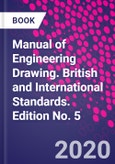Manual of Engineering Drawing: British and International Standards, Fifth Edition, chronicles ISO and British Standards in engineering drawings, providing many examples that will help readers understand how to translate engineering specifications into a visual medium. The book includes 6 introductory chapters which provide foundational theory and contextual information regarding the broader context of engineering drawing and design. The concepts enclosed will help readers gain the most out of their drawing skills. As the standards referred to in this book change every few years, this new edition presents an important update.
Please Note: This is an On Demand product, delivery may take up to 11 working days after payment has been received.
Table of Contents
1. Design office management and organization2. Product development and computer aided design3. Design for manufacture to end of life4. Intellectual property and engineering design5. CAD organization and applications6. Principles of first and third angle orthographic projection7. Linework and lettering8. Three-dimensional illustrations using isometric and oblique projection9. Drawing layouts and simplified methods10. Sections and sectional views11. Geometrical constructions and tangency12. Loci applications13. True lengths and auxiliary views14. Conic sections and interpenetration of solids15. Development of patterns from sheet materials16. Dimensioning principles17. Screw threads and conventional representations18. Nuts, bolts, screws, and washers19. Keys and key ways20. Worked examples in machine drawing21. Limits and fits22. Geometrical tolerancing and datums23. Application of geometrical tolerances24. Maximum material and least material requirements25. Positional tolerancing26. Surface texture27. Surface finish and corrosion of metals28. 3D annotation and product data management29. The Duality Principle e the essential link between the design intent and the verification of the end product30. Differences between American ASME Y 14.5M geometric dimensioning and tolerancing (GD&T) and ISO/BS 8888 geometrical tolerancing standards31. Cams and gears32. Springs33. Welding and welding symbols34. Engineering diagrams35. Bearings and applied technology36. Engineering adhesives37. Related standards38. Production drawings39. Design for additive manufacture40. Drawing solutions








